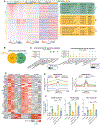Transcription factor protein interactomes reveal genetic determinants in heart disease
- PMID: 35182466
- PMCID: PMC8923057
- DOI: 10.1016/j.cell.2022.01.021
Transcription factor protein interactomes reveal genetic determinants in heart disease
Abstract
Congenital heart disease (CHD) is present in 1% of live births, yet identification of causal mutations remains challenging. We hypothesized that genetic determinants for CHDs may lie in the protein interactomes of transcription factors whose mutations cause CHDs. Defining the interactomes of two transcription factors haplo-insufficient in CHD, GATA4 and TBX5, within human cardiac progenitors, and integrating the results with nearly 9,000 exomes from proband-parent trios revealed an enrichment of de novo missense variants associated with CHD within the interactomes. Scoring variants of interactome members based on residue, gene, and proband features identified likely CHD-causing genes, including the epigenetic reader GLYR1. GLYR1 and GATA4 widely co-occupied and co-activated cardiac developmental genes, and the identified GLYR1 missense variant disrupted interaction with GATA4, impairing in vitro and in vivo function in mice. This integrative proteomic and genetic approach provides a framework for prioritizing and interrogating genetic variants in heart disease.
Keywords: GATA4; GLYR1; NPAC; TBX5; congenital heart disease; de novo variants; disease variants; genetics; protein interactome networks.
Copyright © 2022 Elsevier Inc. All rights reserved.
Conflict of interest statement
Declaration of interests D.S. is scientific co-founder, shareholder, and director of Tenaya Therapeutics. B.G.B. and B.R.C. are scientific co-founders and shareholders of Tenaya Therapeutics. K.S.P. is a shareholder of Tenaya Therapeutics. N.J.K. has received research support from Vir Biotechnology and F. Hoffmann-La Roche. N.J.K. has consulting agreements with the Icahn School of Medicine at Mount Sinai, New York, Maze Therapeutics, and Interline Therapeutics; is a shareholder of Tenaya Therapeutics, Maze Therapeutics, and Interline Therapeutics; and is financially compensated by GEn1E Lifesciences, Inc. and Twist Bioscience Corp.
Figures







Comment in
-
Protein interactomes uncover new genetic causes of CHD.Nat Rev Cardiol. 2022 May;19(5):284-285. doi: 10.1038/s41569-022-00688-8. Nat Rev Cardiol. 2022. PMID: 35296868 No abstract available.
References
-
- Andrews S (2007). A quality control tool for high throughput sequence data. babraham bioinformatics.
-
- Aronesty E 2013. Comparison of Sequencing Utility Programs. The open bioinformatics journal 7(1), pp. 1–8.
MeSH terms
Substances
Grants and funding
- P01 HL089707/HL/NHLBI NIH HHS/United States
- P01 HL146366/HL/NHLBI NIH HHS/United States
- R01 HL127240/HL/NHLBI NIH HHS/United States
- UM1 HL098179/HL/NHLBI NIH HHS/United States
- U01 ES032673/ES/NIEHS NIH HHS/United States
- R01 HL057181/HL/NHLBI NIH HHS/United States
- UM1 HL098166/HL/NHLBI NIH HHS/United States
- T32 HD007470/HD/NICHD NIH HHS/United States
- UM1 HL172717/HL/NHLBI NIH HHS/United States
- U01 MH115747/MH/NIMH NIH HHS/United States
- K08 HL157700/HL/NHLBI NIH HHS/United States
- U01 HL131003/HL/NHLBI NIH HHS/United States
- R03 HL150412/HL/NHLBI NIH HHS/United States
- U01 HL098147/HL/NHLBI NIH HHS/United States
- C06 RR018928/RR/NCRR NIH HHS/United States
LinkOut - more resources
Full Text Sources
Medical
Molecular Biology Databases
Miscellaneous

